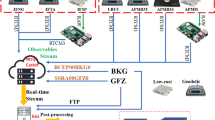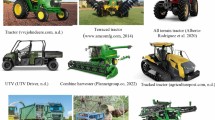Abstract
High Altitude Platform (HAP) must compensate for relative motion with respect to the ground because of the stratosphere complexity, which is important to guarantee Quality of Service(QoS) in intended coverage area. With analysis on HAP movement models for predicting the geographical coverage in the cases of shift horizontally and vertically, yaw, roll and pitch, the mechanisms of steerable antennas movement compensation are investigated. The mechanism is applied to a scenario of 127 cell architecture, with a cell cluster size of four. By the simulation results of Carrier to Interference Ratio (CIR), the steerable antenna movement compensation mechanism decrease influence of HAP movement and guarantee effective coverage of the service area.
Similar content being viewed by others
References
T. C. Tozer and D. Grace. High-altitude platforms for wireless communications. Electronic & Communication Engineering Journal, 13(2001)3, 127–137.
Y. C. Foo, W. L. Lim, R. Tafazolli, and L. Barclay. Other-cell interference and reverse link capacity of high altitude platform station CDMA system. Electronics Letters, 36(2000)22, 1881–1882.
J. Holis and P. Pechac. Elevation dependent shadowing model for mobile communications via high altitude platforms in built-up areas. IEEE Transactions on Antennas and Propagation, 56(2008)4, 1078–1084.
S. Denton, P. Zavidniak, and W. Hodgkiss. High altitude airborne cellular base stations antenna analysis. IEEE Aerospace and Electronic Systems Magazine, 25(2010)4, 30–36.
G. Chen, D. Grace, and T. C. Tozer. Evaluation of the effects of user antenna pointing error in multiple high-altitude platform systems. IET Communications, 1(2007)3, 424–429.
Z. Xu, G. White, and Y. Zakharov. Optimisation of beam pattern of high-altitude platform antenna using conventional beamforming. IEE Proceedings-Communications, 153(2006)6, 865–870.
J. Thornton and D. Grace. Effect of lateral displacement of a high altitude platform on cellular interference and handover. IEEE Transactions on Wireless Communications, 4(2004)4, 1483–1490.
J. Thornton, D. Grace, M. H. Capstick, and T. C. Tozer. Optimising an array of antennas for cellular coverage from a high altitude platform. IEEE Transactions on Wireless Communications, 2(2003)3, 484–492.
C. Oestges. Impact of tropospheric cepolarization on the performance of dual-polarized high-altitude platform systems. IEEE Vehicular Technology Conference, 2008, Singapore, May 11–14, 2008, 2897–2901.
P. Horak and P. Pechac. A study on the possibilities of providing signal coverage for wireless systems from high altitude platforms. 3rd European Conference on Antennas and Propagation, 2009, Berlin, Germany, March 23–27, 2009, 1395–1398.
Author information
Authors and Affiliations
Corresponding author
Additional information
Communication author: Wang Zhenyong, born in 1977, male, Ph.D.
About this article
Cite this article
Wang, Z., Liu, X. & Li, Z. Steerable antennas movement compensation for high altitude platform. J. Electron.(China) 28, 154–160 (2011). https://doi.org/10.1007/s11767-011-0570-4
Received:
Revised:
Published:
Issue Date:
DOI: https://doi.org/10.1007/s11767-011-0570-4
Key words
- High Altitude Platform (HAP)
- Steerable antenna
- Movement compensation
- Carrier to Interference Ratio (CIR)




